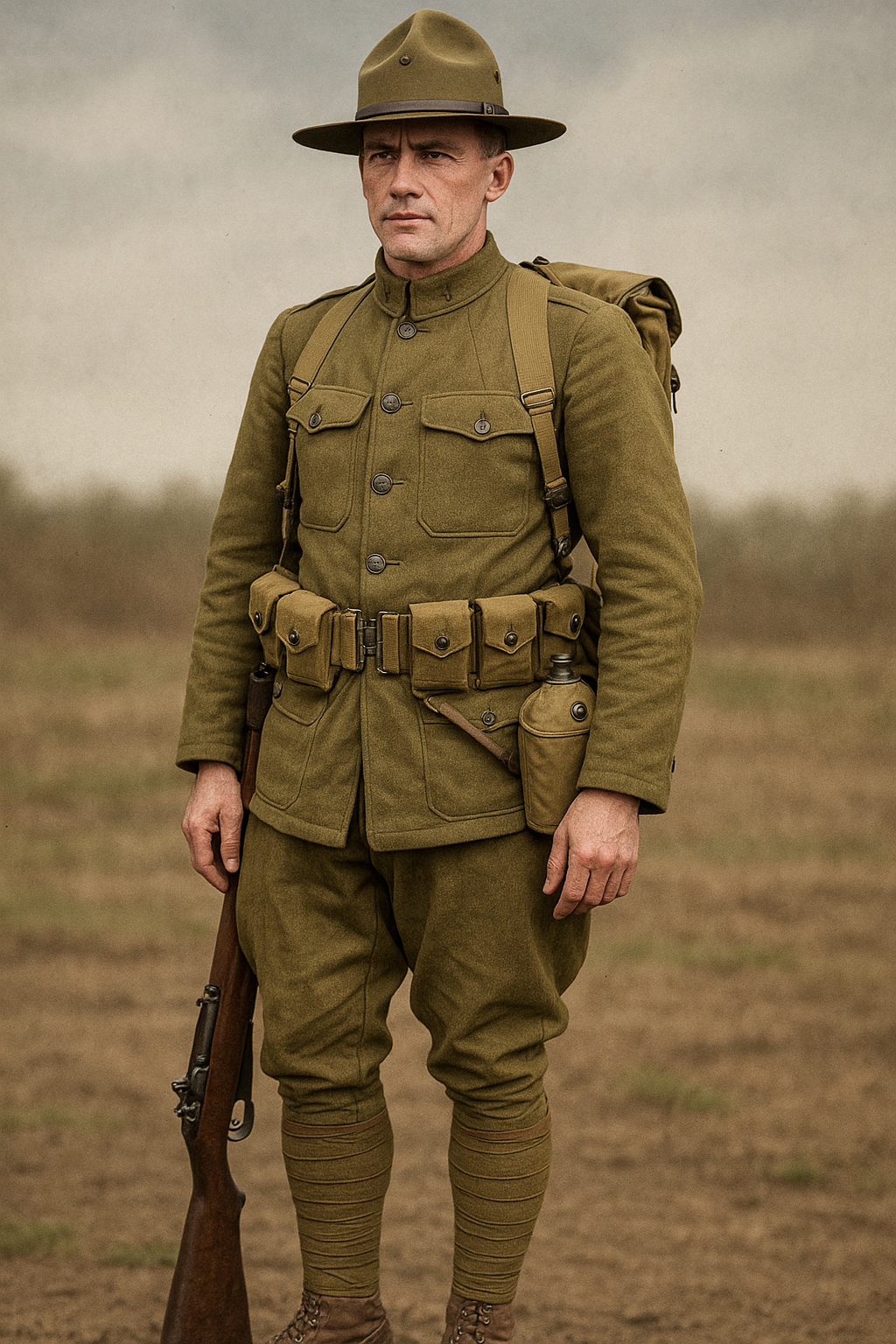
American Soldier Uniform WW1: History, Gear, and Battlefield Style
Published on Jun 25, 2025
American Soldier Uniform WW1: Function, Form, and Legacy
When the United States entered World War I in 1917, American soldiers—nicknamed "Doughboys"—were issued uniforms that reflected both practicality and the evolving demands of modern warfare. Unlike the bright colors of earlier wars, WWI uniforms focused on camouflage, durability, and functionality, making the Doughboy uniform a revolutionary leap in military outfitting.
1. The Shift from Blue to Olive Drab
Before World War I, U.S. military uniforms were mainly based on 19th-century designs, including the iconic dark blue wool coat. However, the need for trench warfare called for earth-toned clothing that blended into the muddy landscapes of Europe. The olive drab wool uniform, officially adopted in the early 20th century, became the standard for American soldiers arriving in France.
Olive drab provided some camouflage and effectively hid dirt and wear—an essential feature for long stints in the trenches without access to regular laundry or resupply.
2. Core Uniform Elements
Let’s break down what the typical WW1 American soldier wore in the field.
M1912 and M1917 Tunics
The main garment was the service coat or tunic. Initially, the M1912 model was issued, but by 1917, an improved version was introduced to handle the colder, harsher European climates. Both were made from heavy wool, with four pockets on the front, shoulder epaulets, and a high, stiff collar.
Wool Breeches
Soldiers wore matching olive-drab breeches—tightly fitted trousers that ended just below the knee. This style reduced snagging and made it easier to wrap puttees (leg wrappings) around the lower legs.
Puttees and Leggings
Wool puttees were wrapped around the soldier’s calves and ankles to support and keep the mud out of their boots. These were standard issues that became recognizable in the Doughboy’s appearance.
Trench Boots
Heavy-duty trench boots replaced early war shoes that wore out quickly in the field. These boots were waterproofed and reinforced with hobnails to handle the muddy, often flooded trench conditions.
Overcoats and Rain Gear
In colder months, soldiers received thick wool overcoats and, if available, rubberized raincoats. Warmth and dryness were essential, as exposure-related illnesses were a significant threat in the trenches.
3. Headgear: Campaign Hat and Brodie Helmet
Soldiers wore the broad-brimmed campaign hat made from felt early in the war. It was stylish but offered little protection in combat. By 1917, the U.S. Army adopted the steel Brodie helmet—a design borrowed from the British. The helmet was crucial in protecting soldiers from shell fragments and overhead shrapnel, common threats in trench warfare.
4. Personal Gear and Webbing
Uniforms were used in conjunction with load-bearing gear. Soldiers carried their essentials on them, often for days or weeks at a time.
M1910 Haversack
This pack system allowed the soldier to carry everything from rations to shelter halves (tent parts). It could be rolled and strapped tightly to the back for mobility.
Canteen and Mess Kit
Each soldier carried a metal canteen, often stored in a wool-lined pouch and a simple mess kit for meals in the field.
Entrenching Tool
A small, foldable shovel or pick was crucial for digging trenches, foxholes, or preparing defensive positions.
Gas Mask
With the introduction of chemical warfare, gas masks became essential. Early versions were rudimentary, but later models offered full-face coverage with respirators and filters.
5. Identification and Insignia
Even in the mud of war, rank and identity mattered.
Rank Chevrons
Non-commissioned officers wore chevrons on the sleeves of their tunics, identifying their position within the unit.
Overseas Service Stripes
Known as “Overseas Chevrons,” these diagonal stripes indicated the length of time a soldier had served abroad—each stripe represented six months of service.
Unit Patches
By late 1918, soldiers began wearing shoulder patches that identified their division or corps. These colorful insignias added a touch of personality and pride to the troops' otherwise uniform appearance.
6. Seasonal Variants and Fatigue Clothing
In warm weather, cotton versions of the uniform were sometimes issued. These were lighter and more breathable than wool. Soldiers often wore fatigue uniforms for labor duties or training—simpler garments made from durable canvas or denim.
7. Officer Distinctions
Officers were often better equipped than enlisted men. In addition to sidearms, they wore Sam Browne belts—a leather harness with a diagonal strap. Officers also had access to private tailors for more refined versions of the standard uniform.
8. Uniform Legacy and Cultural Impact
The WW1 American soldier uniform became one of the most iconic looks of early 20th-century military history. It influenced later designs in World War II and remains popular among historians, collectors, and reenactors today.
The blend of function, simplicity, and rugged design made it timeless. Its olive tones, wool construction, and distinctive silhouette gave the Doughboy a look that was both practical and symbolic of America’s rising military presence on the world stage.
Conclusion
The American soldier uniform of WWI wasn’t just clothing—it was survival gear, psychological armor, and national identity stitched into fabric. From the trench boots to the steel helmet, every element played a role in keeping soldiers alive and effective in one of history’s most brutal conflicts.
Whether you're a military historian, reenactor, or simply curious about wartime life, understanding the WW1 U.S. Army uniform gives insight into the daily lives and challenges of the men who wore it.
